京剧的由来 The History of Peking Opera_英语作文
- 格式:docx
- 大小:16.21 KB
- 文档页数:2
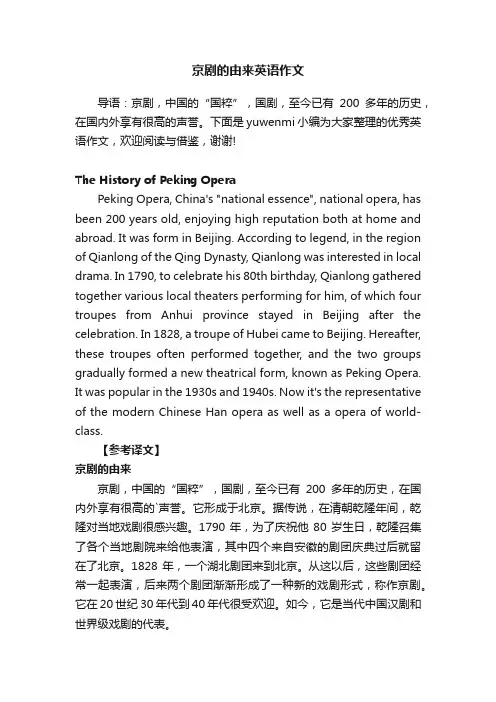
京剧的由来英语作文导语:京剧,中国的“国粹”,国剧,至今已有200多年的历史,在国内外享有很高的声誉。
下面是yuwenmi小编为大家整理的优秀英语作文,欢迎阅读与借鉴,谢谢!The History of Peking OperaPeking Opera, China's "national essence", national opera, has been 200 years old, enjoying high reputation both at home and abroad. It was form in Beijing. According to legend, in the region of Qianlong of the Qing Dynasty, Qianlong was interested in local drama. In 1790, to celebrate his 80th birthday, Qianlong gathered together various local theaters performing for him, of which four troupes from Anhui province stayed in Beijing after the celebration. In 1828, a troupe of Hubei came to Beijing. Hereafter, these troupes often performed together, and the two groups gradually formed a new theatrical form, known as Peking Opera. It was popular in the 1930s and 1940s. Now it's the representative of the modern Chinese Han opera as well as a opera of world-class.【参考译文】京剧的由来京剧,中国的“国粹”,国剧,至今已有200多年的历史,在国内外享有很高的`声誉。
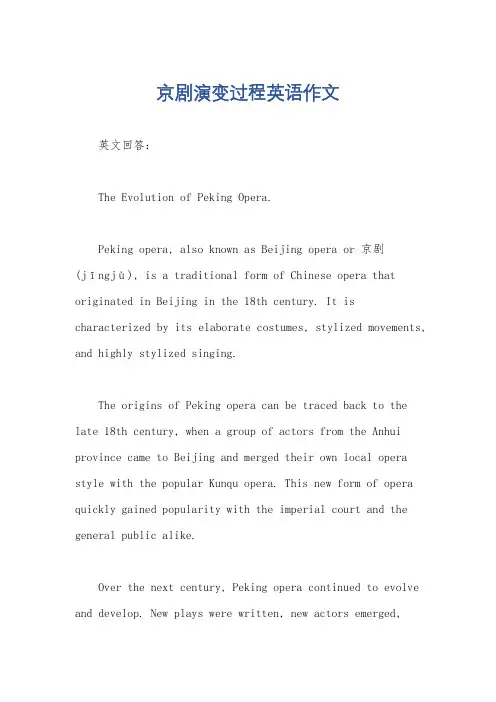
京剧演变过程英语作文英文回答:The Evolution of Peking Opera.Peking opera, also known as Beijing opera or 京剧(jīngjù), is a traditional form of Chinese opera that originated in Beijing in the 18th century. It is characterized by its elaborate costumes, stylized movements, and highly stylized singing.The origins of Peking opera can be traced back to the late 18th century, when a group of actors from the Anhui province came to Beijing and merged their own local opera style with the popular Kunqu opera. This new form of opera quickly gained popularity with the imperial court and the general public alike.Over the next century, Peking opera continued to evolve and develop. New plays were written, new actors emerged,and new techniques were introduced. By the early 20th century, Peking opera had become the most popular form of opera in China.However, the 20th century also brought challenges to Peking opera. The rise of modern theater and the influence of Western culture led to a decline in the popularity of traditional Chinese opera. In the 1960s and 1970s, the Cultural Revolution further damaged Peking opera, as many traditional plays were banned and actors were persecuted.In the post-Mao era, Peking opera has experienced a revival. The government has made efforts to preserve and promote traditional Chinese culture, and Peking opera has once again become a popular form of entertainment. Today, Peking opera is performed all over the world, and it is considered one of the most important and influential forms of Chinese theater.中文回答:京剧的演变。

介绍京剧历史的英语作文The History and Evolution of Peking Opera.Peking Opera, also known as Beijing Opera or Guoju, is a quintessential form of traditional Chinese theater that has a rich and illustrious history spanning several centuries. It is not only a theatrical art but also a cultural icon that represents the essence of Chinese civilization. The origins of Peking Opera can be traced back to the late Ming Dynasty and the early Qing Dynasty, evolving from various local forms of opera into a unified and standardized theatrical style.The earliest predecessor of Peking Opera can be found in the folk songs, dances, and performances of the ancient Han nationality. These performances, known as "Qiang," gradually developed into more elaborate theatrical forms, incorporating elements of storytelling, singing, dialogue, acting, acrobatics, and facial makeup. In the 18th century, during the reign of the Qing Dynasty, these varioustheatrical traditions converged in Beijing, giving birth to what is now known as Peking Opera.One of the defining characteristics of Peking Opera is its emphasis on facial makeup, known as "Lianpu" in Chinese. This elaborate makeup is applied to the actors' faces using various colors and patterns to represent different characters and personalities. For instance, red represents loyalty and bravery, while white signifies treachery and cunning. The makeup is applied in intricate designs, often involving complex patterns and symbols that have.。

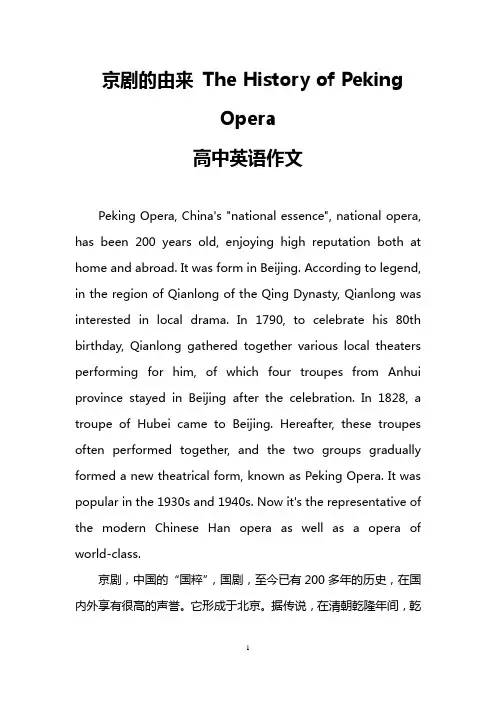
京剧的由来The History of PekingOpera高中英语作文Peking Opera, China's "national essence", national opera, has been 200 years old, enjoying high reputation both at home and abroad. It was form in Beijing. According to legend, in the region of Qianlong of the Qing Dynasty, Qianlong was interested in local drama. In 1790, to celebrate his 80th birthday, Qianlong gathered together various local theaters performing for him, of which four troupes from Anhui province stayed in Beijing after the celebration. In 1828, a troupe of Hubei came to Beijing. Hereafter, these troupes often performed together, and the two groups gradually formed a new theatrical form, known as Peking Opera. It was popular in the 1930s and 1940s. Now it's the representative of the modern Chinese Han opera as well as a opera of world-class.京剧,中国的“国粹”,国剧,至今已有200多年的历史,在国内外享有很高的声誉。

Peking Opera: A Vibrant Embodiment ofBeijing's Cultural HeritagePeking Opera, also known as Pingju in Chinese, is a unique theatrical genre that originated in Beijing, China. It is considered one of the most influential andsignificant forms of performing arts in the country, blending music, dance, acting, and acrobatics into a rich tapestry of visual and auditory experiences. The history of Peking Opera dates back to the 18th century, evolving from various local operatic traditions and eventually becoming a national phenomenon.The allure of Peking Opera lies in its intricate costumes, vivid facial makeup, and the elaborate staging that transports the audience to a world of grandeur and splendor. The costumes, often brightly colored and adorned with intricate embroidery, reflect the status and personality of the characters. The facial makeup, particularly the colorful patterns on the faces of the performers, symbolizes their roles and emotional states, making each character instantly recognizable.The music and singing in Peking Opera are also distinctive, featuring a unique blend of traditional instruments like the gongs and cymbals, the erhu, and the pipa. The melodies are often melodic and harmonious, complementing the emotional depth of the performances. The singing, known as "chanting," requires exceptional breath control and skillful modulation of voice, making it both powerful and expressive.The acting in Peking Opera is renowned for its physicality and exaggeration, with performers often employing gestures and movements that are both highly stylized and deeply emotional. This style of acting, known as "performing with gestures," allows the performers to convey complex emotional states and storylines with remarkable clarity and depth.The acrobatics and martial arts elements in Peking Opera further enhance the visual appeal of the performances. Performers engage in feats of flexibility, balance, and strength, often incorporating martial arts moves into their routines. These acrobatic displays not only amaze theaudience but also serve to emphasize the emotional and narrative arcs of the plays.Peking Opera's repertoire is vast and diverse, covering a wide range of subjects and genres. From historical epics and legends to comic sketches and folk tales, these plays are rich in storytelling and character development. The plots often revolve around themes of love, loyalty, vengeance, and moral dilemmas, reflecting the values and beliefs of Chinese society.Peking Opera is not just a form of entertainment; it is a cultural phenomenon thatreflects the rich history, traditions, and values of the Chinese people. It is a testament to the creativity and genius of generations of performers, composers, writers, and designers who have dedicated their lives to preserving and enhancing this unique theatrical genre.Today, Peking Opera remains a vibrant and relevant part of Chinese culture, attracting both domestic and international audiences. With its enchanting performances and profound narratives, it continues to captivate andinspire people from all over the world, serving as a powerful ambassador for China's rich cultural heritage.**京剧:北京文化遗产的生动体现**京剧,在中国也称为平剧,是一种起源于北京的独特戏剧形式。
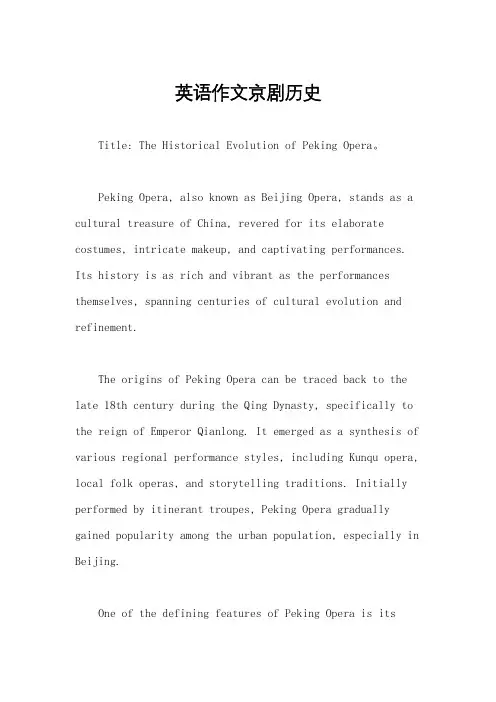
英语作文京剧历史Title: The Historical Evolution of Peking Opera。
Peking Opera, also known as Beijing Opera, stands as a cultural treasure of China, revered for its elaborate costumes, intricate makeup, and captivating performances. Its history is as rich and vibrant as the performances themselves, spanning centuries of cultural evolution and refinement.The origins of Peking Opera can be traced back to the late 18th century during the Qing Dynasty, specifically to the reign of Emperor Qianlong. It emerged as a synthesis of various regional performance styles, including Kunqu opera, local folk operas, and storytelling traditions. Initially performed by itinerant troupes, Peking Opera gradually gained popularity among the urban population, especially in Beijing.One of the defining features of Peking Opera is itsfusion of various art forms, including singing, acting, acrobatics, and martial arts. Performances are characterized by highly stylized movements, symbolic gestures, and rhythmic dialogues. The actors undergo rigorous training from a young age to master these techniques, often specializing in specific roles such as sheng (male roles), dan (female roles), jing (painted face roles), and chou (clown roles).During the 19th century, Peking Opera underwent significant developments, thanks to the patronage of the imperial court and the rise of professional opera troupes. It flourished as a form of entertainment for the elite and the common people alike, with performances staged in teahouses, theaters, and private residences.However, the golden age of Peking Opera came to an abrupt halt with the decline of the Qing Dynasty and the tumultuous events of the early 20th century, including foreign invasions, civil unrest, and the establishment of the Republic of China. The opera faced challenges from modernization and changing social attitudes, leading to adecline in audience numbers and financial support.Nevertheless, Peking Opera managed to survive through sheer resilience and adaptability. In the mid-20th century, it experienced a revival under the auspices of the Chinese government, which recognized its cultural significance and sought to preserve it as a national treasure. Efforts were made to standardize repertoire, training methods, and performance techniques, ensuring the continuity of this traditional art form.Today, Peking Opera continues to enchant audiences both in China and around the world. Its performances are staged in prestigious theaters, festivals, and cultural events, attracting enthusiasts from all walks of life. Moreover, it has transcended its traditional boundaries, inspiring adaptations in literature, film, and other art forms.In conclusion, the history of Peking Opera is a testament to the enduring power of culture and art to transcend time and adversity. From its humble origins toits status as a global phenomenon, it remains a symbol ofChina's rich cultural heritage and artistic legacy. As we celebrate its past achievements and anticipate its future evolution, Peking Opera stands as a timeless masterpiece that will continue to captivate audiences for generations to come.。
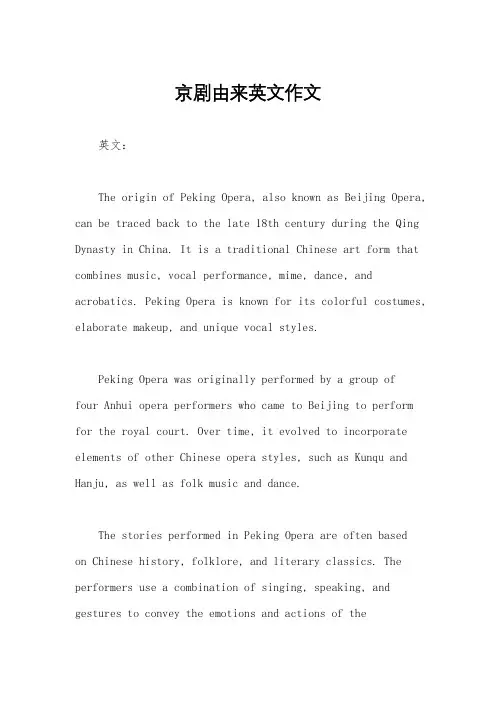
京剧由来英文作文英文:The origin of Peking Opera, also known as Beijing Opera, can be traced back to the late 18th century during the Qing Dynasty in China. It is a traditional Chinese art form that combines music, vocal performance, mime, dance, and acrobatics. Peking Opera is known for its colorful costumes, elaborate makeup, and unique vocal styles.Peking Opera was originally performed by a group offour Anhui opera performers who came to Beijing to perform for the royal court. Over time, it evolved to incorporate elements of other Chinese opera styles, such as Kunqu and Hanju, as well as folk music and dance.The stories performed in Peking Opera are often basedon Chinese history, folklore, and literary classics. The performers use a combination of singing, speaking, and gestures to convey the emotions and actions of thecharacters. The music in Peking Opera is provided by a small ensemble of traditional Chinese instruments, such as the jinghu (a two-stringed fiddle) and the yueqin (a plucked lute).One of the most famous Peking Opera plays is "Farewell My Concubine," which tells the story of the King of Chu and his beloved concubine. The play is known for its dramatic scenes and intricate choreography, as well as the use of symbolic gestures and movements.Peking Opera has a rich and diverse repertoire, with different regional styles and performance techniques. It has been recognized as a UNESCO Intangible Cultural Heritage and continues to be performed and appreciated by audiences around the world.中文:京剧的起源可以追溯到中国清朝晚期的18世纪,是一种结合了音乐、声乐表演、默剧、舞蹈和杂技的传统中国艺术形式。
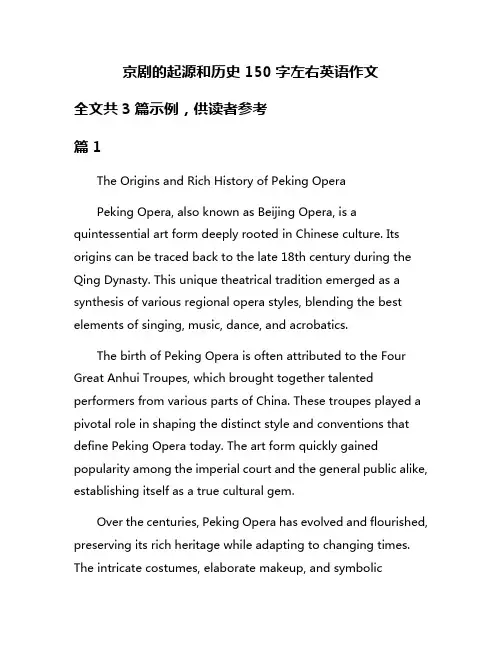
京剧的起源和历史150字左右英语作文全文共3篇示例,供读者参考篇1The Origins and Rich History of Peking OperaPeking Opera, also known as Beijing Opera, is a quintessential art form deeply rooted in Chinese culture. Its origins can be traced back to the late 18th century during the Qing Dynasty. This unique theatrical tradition emerged as a synthesis of various regional opera styles, blending the best elements of singing, music, dance, and acrobatics.The birth of Peking Opera is often attributed to the Four Great Anhui Troupes, which brought together talented performers from various parts of China. These troupes played a pivotal role in shaping the distinct style and conventions that define Peking Opera today. The art form quickly gained popularity among the imperial court and the general public alike, establishing itself as a true cultural gem.Over the centuries, Peking Opera has evolved and flourished, preserving its rich heritage while adapting to changing times. The intricate costumes, elaborate makeup, and symbolicgestures have become iconic representations of this ancient art. The repertoire encompasses a vast array of stories, ranging from historical epics and mythological tales to romantic narratives and moral lessons.Despite facing challenges and periods of decline, Peking Opera has endured as a testament to China's cultural resilience. Today, it continues to captivate audiences worldwide, serving as a living embodiment of China's artistic traditions and a symbol of its enduring cultural legacy.In this essay, we will delve deeper into the fascinating world of Peking Opera, exploring its origins, evolution, and enduring significance as a cherished art form that has transcended borders and generations.The Origins of Peking OperaPeking Opera, or Beijing Opera, traces its roots to the late 18th century during the Qing Dynasty (1644-1912). However, its foundations were laid much earlier, drawing inspiration from various regional opera styles that flourished across China. The art form emerged as a synthesis of these diverse traditions, blending the best elements of singing, music, dance, and acrobatics.The birth of Peking Opera is often attributed to the Four Great Anhui Troupes, which brought together talented performers from various parts of China, particularly the provinces of Anhui, Hubei, and Shaanxi. These troupes played a pivotal role in shaping the distinct style and conventions that define Peking Opera today.The Four Great Anhui Troupes were:The Anhui Troupe, led by the renowned performer Gao Zhengguo.The Hubei Troupe, led by the celebrated actor Mei Lanfang.The Sizhou Troupe, known for its innovative techniques and staging.The Handan Troupe, renowned for its skilled performers and unique regional style.These troupes brought together a diverse array of talents, combining the best elements from various regional opera styles, such as kunqu, xipi, and huagu. Through their collaborations and artistic exchanges, they laid the foundations for what would become the rich and multifaceted art form of Peking Opera.The troupes performed in the imperial court and gained immense popularity among the ruling Qing aristocracy and thegeneral public alike. Their performances captivated audiences with their intricate movements, expressive singing, and vibrant costumes, setting the stage for the emergence of Peking Opera as a distinct and highly revered art form.The Evolution of Peking OperaAs Peking Opera gained widespread popularity and recognition, it underwent a process of evolution and refinement, adapting to changing times and artistic influences. This evolution can be broadly divided into three distinct periods:The Formative Years (Late 18th Century - Mid-19th Century)During this period, Peking Opera solidified its unique style and conventions. The performances were characterized by a blend of singing, dancing, and acrobatics, accompanied by traditional Chinese musical instruments such as the jinghu (a high-pitched fiddle) and the clappers.The costumes and makeup also became more elaborate, with each character's attire and facial painting carrying symbolic meanings and representing different roles and personalities. The repertoire during this time focused primarily on historical tales and mythological stories, often drawing from classic novels and operas.The Golden Age (Mid-19th Century - Early 20th Century)The mid-19th century marked the beginning of Peking Opera's golden age, a period of artistic excellence and widespread popularity. This era saw the emergence of legendary performers such as Mei Lanfang, Cheng Yanqiu, and Xun Huisheng, who elevated the art form to new heights and became cultural icons.During this time, Peking Opera became more refined and sophisticated, with a greater emphasis on vocal techniques, choreography, and character development. The repertoire expanded to include a wider range of themes, including romantic narratives and moral lessons, reflecting the changing social and cultural landscape of the time.The introduction of new staging techniques, such as the use of trap doors and revolving stages, added an extra layer of complexity and excitement to the performances, captivating audiences with their ingenuity and spectacle.The Modern Era (20th Century - Present)As China underwent significant political and social changes in the 20th century, Peking Opera faced both challenges and opportunities for reinvention. During the Cultural Revolution(1966-1976), the art form experienced a period of suppression and decline, as it was deemed bourgeois andcounter-revolutionary by the ruling authorities.However, in the post-Cultural Revolution era, Peking Opera experienced a resurgence, with efforts made to preserve and revive this ancient art form. New adaptations and modern interpretations emerged, incorporating contemporary themes and elements while still retaining the core essence of Peking Opera.Today, Peking Opera continues to captivate audiences worldwide, serving as a living embodiment of China's artistic traditions and a symbol of its enduring cultural legacy. Renowned troupes and performers have taken the art form to international stages, introducing it to new audiences and fostering cross-cultural appreciation and understanding.The Enduring Significance of Peking OperaPeking Opera holds a special place in Chinese culture, transcending its role as a mere art form and becoming a national treasure deeply ingrained in the country's rich heritage. Its enduring significance can be attributed to several factors:Cultural Preservation and TransmissionPeking Opera serves as a living repository of Chinese cultural traditions, preserving and transmitting the country's history, values, and customs through its intricate stories and symbolic gestures. It acts as a bridge between the past and the present, allowing generations to connect with their cultural roots and appreciate the richness of their heritage.Artistic Expression and VirtuosityThe art form demands exceptional skill and dedication from its performers, who undergo rigorous training in various disciplines such as singing, acting, martial arts, and acrobatics. Peking Opera showcases the virtuosity of Chinese artists, captivating audiences with their mastery of the art form's intricate techniques and conventions.Social and Moral TeachingsMany Peking Opera productions carry important social and moral messages, serving as vehicles for imparting wisdom and reinforcing cultural values. Through the exploration of complex characters and their struggles, the art form offers insights into human nature, ethical dilemmas, and the pursuit of virtues such as loyalty, filial piety, and justice.Cross-Cultural Exchange and DiplomacyIn recent decades, Peking Opera has transcended national borders, becoming a powerful tool for cultural diplomacy and cross-cultural exchange. International tours and collaborations have introduced the art form to new audiences, fostering greater appreciation and understanding of Chinese culture worldwide.Tourism and Economic OpportunitiesPeking Opera has also become a significant draw for cultural tourism, attracting visitors from around the world who are eager to experience this unique art form. This has generated economic opportunities for performers, theaters, and associated industries, contributing to the preservation and promotion of this rich cultural heritage.ConclusionPeking Opera is a true masterpiece of Chinese culture, a testament to the country's artistic traditions and resilience. Its origins can be traced back to the late 18th century, when the Four Great Anhui Troupes played a pivotal role in shaping its distinct style and conventions.Over the centuries, Peking Opera has evolved and flourished, adapting to changing times while preserving its rich heritage. Its intricate costumes, elaborate makeup, and symbolic gestureshave become iconic representations of this ancient art form, captivating audiences worldwide.Despite facing challenges and periods of decline, Peking Opera has endured as a living embodiment of China's cultural legacy, serving as a bridge between the past and the present. Its enduring significance lies in its ability to preserve and transmit cultural traditions, showcase artistic virtuosity, impart social and moral teachings, foster cross-cultural exchange, and generate economic opportunities through cultural tourism.As the world continues to appreciate and embrace the richness of diverse cultures, Peking Opera stands as a sh篇2The Captivating World of Peking Opera: A Journey Through TimeAs a student of the arts, I have always been drawn to the rich tapestry of cultural heritage woven into the fabric of traditional performances. Among these, the illustrious Peking Opera stands as a shining beacon, a testament to the enduring spirit of Chinese culture and its ability to captivate audiences across generations.Tracing its roots back to the late 18th century, Peking Opera emerged as a fusion of various regional opera styles, blending the best of acting, singing, martial arts, and acrobatics into a mesmerizing spectacle. Its origins can be traced to the humble tea houses and theaters of Beijing, where performers would regale patrons with tales of emperors, warriors, and folk heroes.At the heart of Peking Opera lies a meticulously crafted symphony of artistic disciplines. The elaborate costumes and intricate makeup, each stroke a masterpiece in itself, transport the audience into a world of vibrant hues and symbolic meanings. The melodic arias, sung in a unique operatic style, weave intricate narratives that tug at the heartstrings of the audience.But Peking Opera is more than just a visual and auditory feast; it is a living embodiment of China's cultural heritage. The movements, gestures, and combat sequences are intricately choreographed, drawing from centuries of martial arts traditions. Every aspect of the performance, from the stylized movements to the symbolic props, carries a depth of meaning that resonates with the collective consciousness of the Chinese people.As a student, I am in awe of the dedication and discipline required to master this art form. The years of rigorous training, the unwavering commitment to preserving tradition, and theability to breathe life into ancient tales are nothing short of remarkable. Peking Opera performers are not merely artists; they are guardians of a cultural legacy that spans centuries.Yet, Peking Opera is not a relic of the past; it is a living, evolving tradition that continues to captivate modern audiences. Its enduring popularity is a testament to its ability to transcend cultural barriers and connect with the universal human experience. As I delve deeper into the world of Peking Opera, I am reminded of the power of art to bridge divides, to educate, and to inspire.In the grand tapestry of human civilization, Peking Opera stands as a vibrant thread, weaving together the rich tapestry of Chinese culture with the universal language of storytelling. It is a celebration of tradition, a testament to artistic mastery, and a window into the soul of a nation. As a student, I am grateful for the opportunity to study and appreciate this art form, for it is not merely a performance but a living, breathing embodiment of a cultural heritage that transcends time and borders.篇3The Origins and Rich History of Peking OperaAs a student passionate about the arts, I have always been fascinated by the vibrant and captivating world of Peking Opera, also known as Beijing Opera. This traditional Chinese art form, with its intricate makeup, elaborate costumes, and mesmerizing performances, has a rich history that spans centuries and continues to enchant audiences worldwide.Peking Opera's roots can be traced back to the late 18th century during the Qing Dynasty. It emerged as a unique synthesis of various regional opera styles, blending the melodic tunes of Kunqu Opera from Jiangsu Province with the acrobatic movements of Hui Opera from Anhui Province and the vocal techniques of Xiangshu Opera from Hubei Province. This fusion gave birth to a distinct and captivating art form that quickly gained popularity among the imperial court and the commoners alike.The golden age of Peking Opera flourished during the reign of the Qing emperors, particularly under the patronage of the Qianlong Emperor, who was an ardent supporter of the arts. During this period, renowned playwrights and performers emerged, crafting masterpieces that have become timeless classics. The Four Great Scholars of the Qing Dynasty – Kong Shangren, Li Yu, Hong Sheng, and Bi Changcai – made significantcontributions to the development of Peking Opera, elevating it to new heights of artistry and sophistication.Peking Opera's repertoire encompasses a diverse range of stories and themes, drawing inspiration from historical events, folklore, and literary works. The plays often depict tales of loyalty, valor, romance, and moral lessons, captivating audiences with their intricate plots and captivating characters. The performances are a feast for the senses, combining vocal techniques, instrumental music, intricate movements, and stunning costumes and makeup.One of the defining features of Peking Opera is its unique system of role types, known as the "Four Principals" – Sheng (male roles), Dan (female roles), Jing (painted faces representing loyalty and bravery), and Chou (comic roles). Each role type has its own distinct singing styles, movement patterns, and makeup designs, adding depth and complexity to the performances.Throughout its history, Peking Opera has faced challenges and periods of decline, but it has always managed to endure and adapt to changing times. In the early 20th century, the art form underwent a revival, with new innovations and modernizations introduced to appeal to contemporary audiences. Today, Peking Opera continues to thrive, both in China and on internationalstages, captivating audiences with its timeless artistry and cultural significance.As a student of the arts, I am constantly in awe of the rich heritage and cultural significance of Peking Opera. Its ability to seamlessly blend music, dance, acting, and martial arts into a cohesive and mesmerizing performance is truly remarkable. Peking Opera stands as a testament to the enduring power of art and its ability to transcend boundaries and connect people across cultures and generations.。
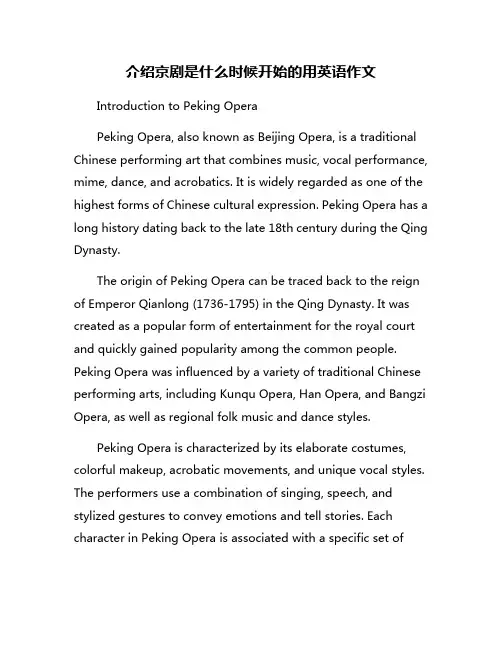
介绍京剧是什么时候开始的用英语作文Introduction to Peking OperaPeking Opera, also known as Beijing Opera, is a traditional Chinese performing art that combines music, vocal performance, mime, dance, and acrobatics. It is widely regarded as one of the highest forms of Chinese cultural expression. Peking Opera has a long history dating back to the late 18th century during the Qing Dynasty.The origin of Peking Opera can be traced back to the reign of Emperor Qianlong (1736-1795) in the Qing Dynasty. It was created as a popular form of entertainment for the royal court and quickly gained popularity among the common people. Peking Opera was influenced by a variety of traditional Chinese performing arts, including Kunqu Opera, Han Opera, and Bangzi Opera, as well as regional folk music and dance styles.Peking Opera is characterized by its elaborate costumes, colorful makeup, acrobatic movements, and unique vocal styles. The performers use a combination of singing, speech, and stylized gestures to convey emotions and tell stories. Each character in Peking Opera is associated with a specific set ofmovements, gestures, and vocal techniques that help to define their personality and role in the story.Peking Opera often features historical dramas, mythology, and folk tales, with themes of loyalty, honor, and love. The stories are typically based on Chinese history and legends, such as the famous novel "Romance of the Three Kingdoms" or the classic play "The Peony Pavilion." Peking Opera performances are accompanied by a traditional Chinese orchestra, which typically includes stringed instruments, percussion, and wind instruments.Over the centuries, Peking Opera has evolved and adapted to changing times, but it has remained a beloved cultural tradition in China. Today, Peking Opera continues to be performed in theaters and opera houses across China and around the world. Its unique blend of music, dance, and drama has captivated audiences for generations and continues to inspire new generations of performers and fans.。
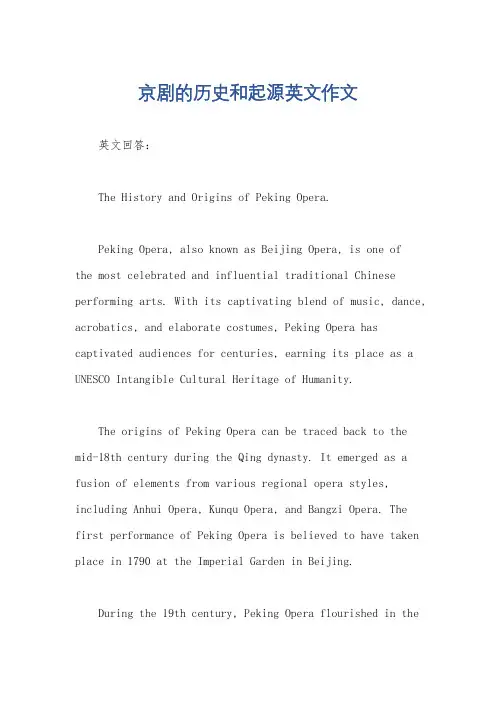
京剧的历史和起源英文作文英文回答:The History and Origins of Peking Opera.Peking Opera, also known as Beijing Opera, is one ofthe most celebrated and influential traditional Chinese performing arts. With its captivating blend of music, dance, acrobatics, and elaborate costumes, Peking Opera has captivated audiences for centuries, earning its place as a UNESCO Intangible Cultural Heritage of Humanity.The origins of Peking Opera can be traced back to the mid-18th century during the Qing dynasty. It emerged as a fusion of elements from various regional opera styles, including Anhui Opera, Kunqu Opera, and Bangzi Opera. The first performance of Peking Opera is believed to have taken place in 1790 at the Imperial Garden in Beijing.During the 19th century, Peking Opera flourished in thecapital city and became the dominant form of Chinese opera. It was patronized by the imperial court and wealthy patrons, who commissioned the creation of new plays and aesthetized performances. The establishment of the Four Great Troupes– Sanqing, Siguxi, Chuntai, and Fuliancheng – marked the golden age of Peking Opera, with each troupe developing its unique style and repertoire.In the 20th century, Peking Opera underwent significant changes as it adapted to modern society. It gained a wider audience through the development of radio, film, and television. However, the Cultural Revolution of the 1960s and 1970s suppressed traditional arts like Peking Opera, leading to its decline.After the Cultural Revolution, Peking Opera experienced a resurgence. The government recognized its cultural significance and implemented measures to preserve and promote the art form. Today, Peking Opera is performed throughout China and around the world, delighting audiences with its timeless beauty and artistry.The Structure and Aesthetics of Peking Opera.Peking Opera is renowned for its distinctive structure, stagecraft, and aesthetics. A typical performance consistsof several acts, each featuring a combination of music, singing, dialogue, and acrobatics. The stage is usually bare, with minimal props, allowing actors to showcase their skills through stylized movements and gestures.The elaborate costumes and makeup are an integral partof Peking Opera. The costumes are adorned with intricate embroidery, beadwork, and sequins, representing the characters' social status and personalities. The facial makeup, known as "jinghu," follows a highly codified system, with specific patterns and colors denoting different character types.The music of Peking Opera is played by a smallorchestra consisting of strings, percussion, and wind instruments. The melodies are often haunting and evocative, setting the mood and atmosphere of the performance. The vocals are characterized by a high-pitched, nasal singingstyle, accompanied by rhythmic speech patterns.The Legacy of Peking Opera.Peking Opera has had a profound impact on Chinese culture and has influenced numerous other art forms, including literature, film, and music. It has also played a significant role in promoting Chinese culture internationally, captivating audiences with its artistry and storytelling.Today, Peking Opera remains a vibrant and evolving art form. While preserving its traditional roots, it continues to incorporate new elements and interpretations, ensuring its enduring appeal for generations to come.中文回答:京剧的历史和起源。
京剧的历史和起源英文作文English Answer:The history and origin of Beijing opera, also known as Peking opera, can be traced back to the late 18th century during the Qing Dynasty in China. It was developed in Beijing and quickly became one of the most popular forms of entertainment in the city. Beijing opera combines elements of singing, dancing, acting, and acrobatics, making it a comprehensive art form.The origins of Beijing opera can be attributed to four major regional opera styles that were popular in different parts of China at the time: Anhui opera, Hubei opera, Hebei opera, and Shanxi opera. These regional styles influenced the development of Beijing opera and contributed to its unique characteristics.Anhui opera, known for its singing and dancing, brought the melodic and rhythmic elements to Beijing opera. Hubeiopera, with its emphasis on martial arts and acrobatics, added the physicality and acrobatic movements to the art form. Hebei opera, which focused on spoken dialogue and acting, influenced the vocal techniques and acting style of Beijing opera. Shanxi opera, with its elaborate costumes and makeup, contributed to the visual aesthetics of Beijing opera.As Beijing opera continued to evolve, it incorporated elements from other art forms, such as folk music, traditional Chinese poetry, and storytelling. This fusion of different art forms created a rich and diverserepertoire of stories and characters in Beijing opera.One of the most famous characters in Beijing opera is the "Monkey King" from the classic Chinese novel "Journey to the West." The Monkey King is known for his mischievousness, bravery, and magical powers. His character is often portrayed with exaggerated facial expressions, acrobatic movements, and powerful vocal techniques. The Monkey King has become an iconic figure in Beijing opera and is loved by audiences around the world.中文回答:京剧的历史和起源可以追溯到中国清朝晚期的18世纪末。
京剧的起源和历史150字左右作文英文回答:Origins and History of Peking Opera.Peking Opera, a traditional Chinese art form that combines music, dance, acrobatics, and acting, has a rich and complex history dating back centuries. It is believed to have originated in the late 18th century in Anhui Province, during the reign of Emperor Qianlong of the Qing Dynasty.Initially, Peking Opera was known as "Huiju" or "Pihuang," and was performed by troupes of actors who traveled around the country. By the mid-19th century, it had become popular in Beijing, where it was adopted by the imperial court and became known as "Jingju" or "Peking Opera."Peking Opera is characterized by its distinctive vocalstyle, elaborate costumes, and stylized movements. The singing is based on two main vocal categories: "sheng" (male roles) and "dan" (female roles). The costumes are highly elaborate, often adorned with intricate embroidery and accessories. The movements are stylized and symbolic, representing specific emotions or actions.Over the centuries, Peking Opera has undergone numerous changes and developments. New styles and techniques have been introduced, and the repertoire of plays has expanded to include a wide range of themes and stories. Today, Peking Opera is a highly respected art form, recognized both in China and abroad for its cultural and artistic value.中文回答:京剧,一种结合了音乐、舞蹈、杂技和表演的中国传统艺术形式,有着悠久而复杂的起源和历史。
京剧的历史和起源英文作文The History and Origin of Peking Opera.Peking Opera, also known as Pingju in China, is a unique form of traditional Chinese theater that combines music, dance, acting, acrobatics, and mime. It is widely regarded as one of the most significant cultural expressions of China, embodying centuries of historical, artistic, and social evolution. The rich tapestry of Peking Opera reflects not only the refinement and sophistication of Chinese aesthetics but also the depth and complexity of Chinese society.Tracing the origins of Peking Opera is a challenging task, as its history is intertwined with the cultural and historical developments of China. It is believed to have evolved from various local operatic traditions that existed in the capital city of Beijing (known as Peking during the Qing dynasty) and its surrounding regions. These local traditions, known as "huiban," were primarily based on folkmusic and dance, and were performed by traveling troupes.The earliest recorded performance of Peking Opera dates back to the 18th century, during the reign of the Qianlong Emperor in the Qing dynasty. However, scholars believe that the roots of Peking Opera can be traced even earlier, to the Yuan dynasty, when a form of opera known as "Zaju" was popular. Zaju was a blend of various performing arts, including music, dance, and drama, and it was performed by professional troupes.The development of Peking Opera was significantly influenced by two major events in Chinese history. Thefirst was the establishment of Beijing as the capital city of the Qing dynasty in 1644. This event brought together various cultural and artistic traditions from different regions of China, creating a fertile ground for the emergence of a new operatic form. The second event was the banning of operatic performances by the Qing court in 1790, which forced the operatic troupes to relocate to Beijing and seek new audiences and patronage.In Beijing, these troupes merged with the local huiban traditions, adopting and adapting their music, dance, and acting styles. Over time, Peking Opera evolved into ahighly codified and formalized form of theater, with a repertory of standardized plays and roles. The operatic canon includes both historical and mythical dramas, as well as comedies and farces.The musical accompaniment of Peking Opera is typically provided by a combination of percussion instruments, stringed instruments, and wind instruments. The most characteristic instrument of Peking Opera is the "jinghu,"a two-stringed fiddle that provides the melodic backbone of the music. The acting style of Peking Opera is characterized by highly stylized and exaggerated movements, known as "gongfu," which combine acrobatics, mime, and dance.The costumes and staging of Peking Opera are also significant elements of its aesthetic appeal. The costumes, known as "xingtou," are highly decorative and colorful, often incorporating symbols and motifs that reflect thestatus and personality of the characters. The staging, known as "bujing," is equally elaborate, with scenic elements that are designed to enhance the emotional and narrative impact of the performance.Peking Opera has always been a popular form of entertainment among the Chinese people, and it has also served as a medium for social and political commentary. Throughout its history, Peking Opera has been influenced by various social and political movements, and it has often been used as a tool for promoting cultural and national identity.Today, Peking Opera remains a vibrant and importantpart of Chinese culture. It is performed regularly in theaters and concert halls throughout China, and it is also exported to other countries as a symbol of Chinese cultural heritage. While the form has evolved over the centuries,its essential characteristics – including its music, dance, acting, and staging – remain true to its original roots.In conclusion, the history and origin of Peking Operaare deeply rooted in the cultural and historical soil of China. Its evolution from local huiban traditions to a highly codified and formalized form of theater reflects the rich diversity and dynamic nature of Chinese culture. As a unique and enduring expression of Chinese aesthetics and society, Peking Opera continues to captivate and inspire audiences worldwide.。
京剧的历史和起源英文作文English Answer:Origins and History of Peking Opera.Peking opera, also known as Beijing opera, is a highly stylized and elaborate form of traditional Chinese theater that originated in Beijing in the mid-18th century. It is considered one of the most important and influential formsof Chinese theater, and is admired for its elaborate costumes, distinctive makeup, and highly skilled performers.The origins of Peking opera can be traced back to the late Ming and early Qing dynasties. During this time, various forms of folk drama and local theatrical forms emerged throughout China, including Kunqu opera andregional operas like Anhui opera and Hebei opera. These forms of theater eventually made their way to Beijing,where they began to merge and evolve into a new form of opera.In the mid-18th century, Emperor Qianlong of the Qing dynasty commissioned the creation of a new type of opera that would combine the best elements of existing theatrical forms. This new opera, known as Peking opera, was first performed in 1790 at the Lanling Theater in Beijing.Peking opera quickly became popular among the imperial court and the general public. It spread to other parts of China and became the dominant form of Chinese opera in the 19th and 20th centuries.Characteristics of Peking Opera.Peking opera is characterized by a number ofdistinctive features, including:Elaborate costumes and makeup: Peking opera performers wear elaborate costumes and distinctive makeup that helps to create the characters they portray.Highly skilled performers: Peking opera performers arehighly skilled in singing, dancing, and martial arts. They undergo years of training to develop the skills necessary to perform Peking opera.Distinctive musical style: Peking opera is accompanied by a unique musical style that uses a combination of traditional Chinese instruments, including the pipa, erhu, and gongs.Symbolism and allegory: Peking opera makes extensive use of symbolism and allegory. The costumes, makeup, and props all have specific meanings that can be interpreted by the audience.Themes of Peking Opera.Peking opera covers a wide range of themes, including:Historical events: Many Peking opera plays are based on historical events, such as the Three Kingdoms period or the Ming dynasty.Traditional Chinese stories: Peking opera also includes plays that are based on traditional Chinese stories, such as the story of Mulan or the Monkey King.Social and political issues: Peking opera can also address social and political issues, such as corruption or poverty.Legacy of Peking Opera.Peking opera has had a lasting impact on Chinese culture. It has inspired many other forms of Chinese theater and art, and it continues to be performed and enjoyed by audiences around the world. Peking opera is considered a national treasure of China, and it is protected by the government as an important part of Chinese cultural heritage.中文回答:京剧的历史和起源。
英语作文京剧的介绍Peking Opera: A Traditional Chinese Art Form。
Peking Opera, also known as Beijing Opera, is one of the most well-known traditional Chinese art forms. It combines music, singing, dance, and acrobatics to create a unique and captivating theatrical experience. Peking Opera has a history of over 200 years and is considered acultural treasure of China.The origins of Peking Opera can be traced back to the late 18th century during the Qing Dynasty. It was initially performed for the royal court and later gained popularity among the common people. Peking Opera incorporates elements of various regional opera styles, such as Hui Opera, Kun Opera, and Qinqiang Opera, to create a distinct and vibrant art form.One of the distinguishing features of Peking Opera is its elaborate costumes and makeup. The performers wearbrightly colored costumes adorned with intricate embroidery and accessories. The makeup, known as "jing," is characterized by bold and exaggerated facial patterns that symbolize the characters' personalities and emotions. The different colors and patterns used in the makeup help the audience identify the characters and their roles in the performance.Another notable aspect of Peking Opera is its unique singing style. The performers use a technique called "jinghuang," which combines singing, recitation, and stylized speech. The singing is melodic and rhythmic, with the performers often using falsetto or high-pitched voices to convey different emotions. The recitation involves the rhythmic delivery of lines, while the stylized speech emphasizes the pronunciation and enunciation of words.Peking Opera performances are usually accompanied by a small orchestra, which consists of traditional Chinese instruments such as the erhu, pipa, and bamboo flute. The music played by the orchestra complements the singing and acting on stage, creating a harmonious and immersiveexperience for the audience.The plots of Peking Opera are often based on historical events, legends, or classical Chinese literature. The performances typically revolve around themes of loyalty, love, and justice. The actors portray a wide range of characters, including emperors, generals, scholars, and warriors. Each character has a specific role and is characterized by their costume, makeup, and performance style.Peking Opera is not only a form of entertainment but also a cultural symbol of China. It has been recognized by UNESCO as an Intangible Cultural Heritage of Humanity, highlighting its significance and influence on Chinese culture. Despite the modernization of China, Peking Opera continues to thrive and attract audiences both domestically and internationally.In recent years, efforts have been made to promote and preserve Peking Opera. Various Peking Opera troupes and schools have been established to train and nurture youngtalents. Additionally, Peking Opera has been adapted into modern forms, such as films and television dramas, to appeal to a wider audience.In conclusion, Peking Opera is a traditional Chineseart form that combines music, singing, dance, and acrobatics. With its elaborate costumes, unique makeup, and distinctive singing style, Peking Opera offers a visually stunning and emotionally engaging theatrical experience. As a cultural treasure of China, Peking Opera continues to captivate audiences and preserve the rich heritage of Chinese performing arts.。
京剧的起源作文500字英文回答:The origins of Peking Opera, a genre of Chinese opera, can be traced back to the late 18th century in Beijing. It emerged from the fusion of various regional opera forms, such as Kunqu, Bangzi, and Qinqiang, which were popular in different parts of China. The development of Peking Opera was influenced by the cultural and political environment of the Qing dynasty, and it became an important form of entertainment for both the imperial court and the general public.Peking Opera is characterized by its elaborate costumes, stylized makeup, and highly formalized gestures and movements. The performance involves singing, dancing, and martial arts, and the storylines often draw inspirationfrom historical events and legends. The musical accompaniment is provided by a small orchestra consistingof percussion instruments and stringed instruments, and thevocal style is distinctive with its high-pitched falsetto singing.Peking Opera achieved its greatest popularity during the late 19th and early 20th centuries, and it became a symbol of Chinese culture and tradition. It has been passed down through generations of performers, and it continues to be performed in theaters and opera houses around the world.中文回答:京剧起源于18世纪末的北京,是由昆曲、梆子、秦腔等不同地方戏曲形式融合而成。
京剧的由来The History of Peking Opera
Peking Opera, China's "national essence", national opera, has been 200 years old, enjoying high reputation both at home and abroad. It was form in Beijing. According to legend, in the region of Qianlong of the Qing Dynasty, Qianlong was interested in local drama. In 1790, to celebrate his 80th birthday, Qianlong gathered together various local theaters performing for him, of which four troupes from Anhui province stayed in Beijing after the celebration. In 1828, a troupe of Hubei came to Beijing. Hereafter, these troupes often performed together, and the two groups gradually formed a new theatrical form, known as Peking Opera. It was popular in the 1930s and 1940s. Now it's the representative of the modern Chinese Han opera as well as a opera of world-class.
京剧,中国的“国粹”,国剧,至今已有200多年的历史,在国内外享有很高的声誉。
它形成于北京。
据传说,在清朝乾隆年间,乾隆对当地戏剧很感兴趣。
1790年,为了庆祝他80岁生日,乾隆召集了各个当地剧院来给他表演,其中四个来自安徽的剧团庆典过后就留在了北京。
1828年,一个湖北剧团来到北京。
从这以后,这些剧团经常一起表演,后来两个剧团渐渐形成了一种新的戏剧形式,称作京剧。
它在20世纪30年代到40年代很受欢迎。
如今,它是当代中国汉剧和世界级戏剧的代表。